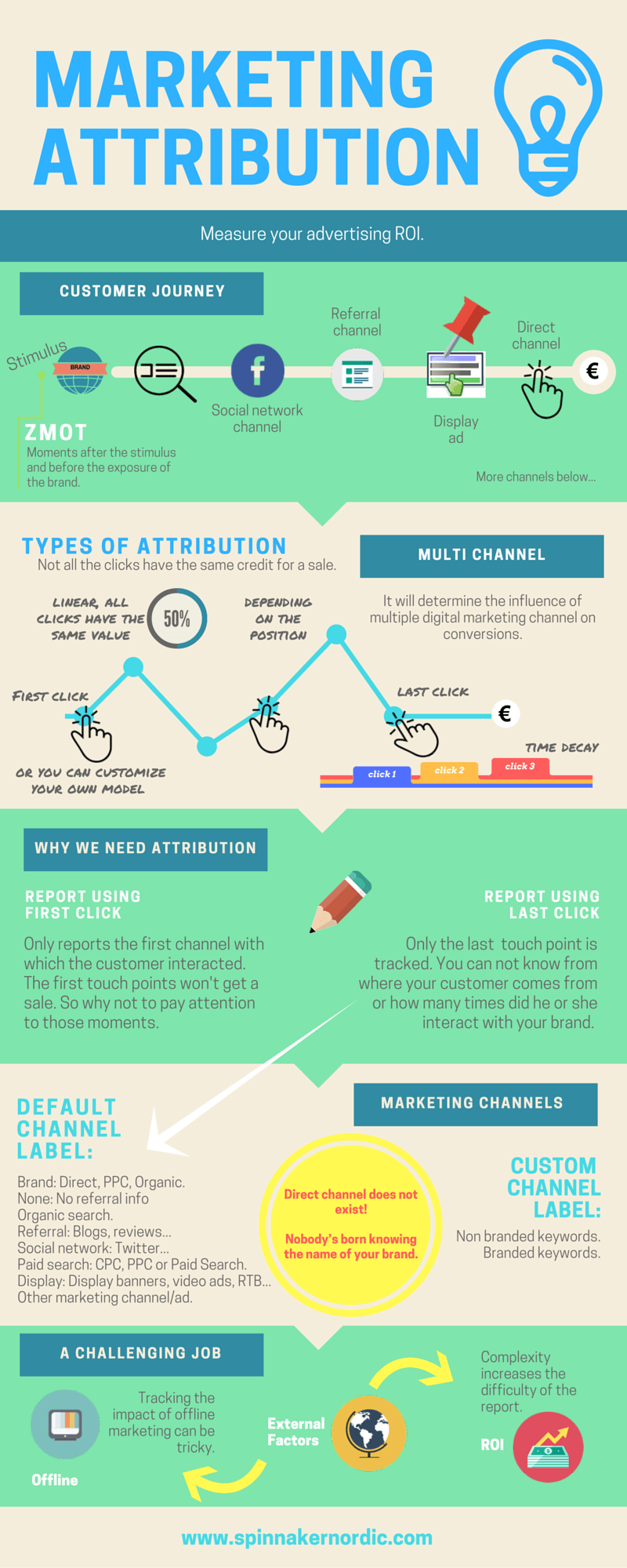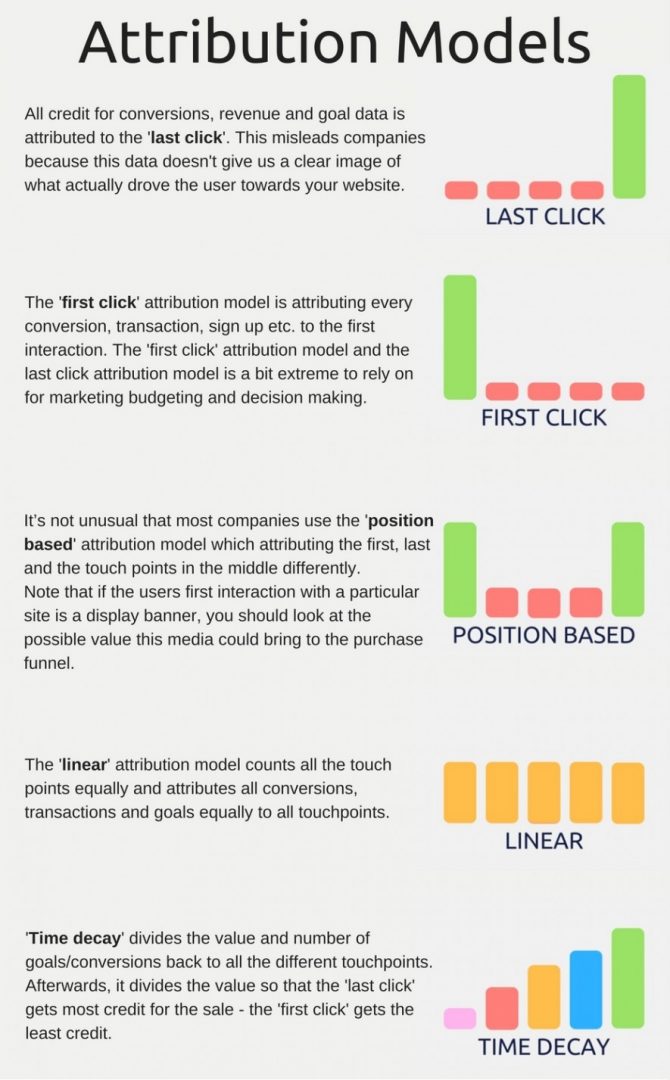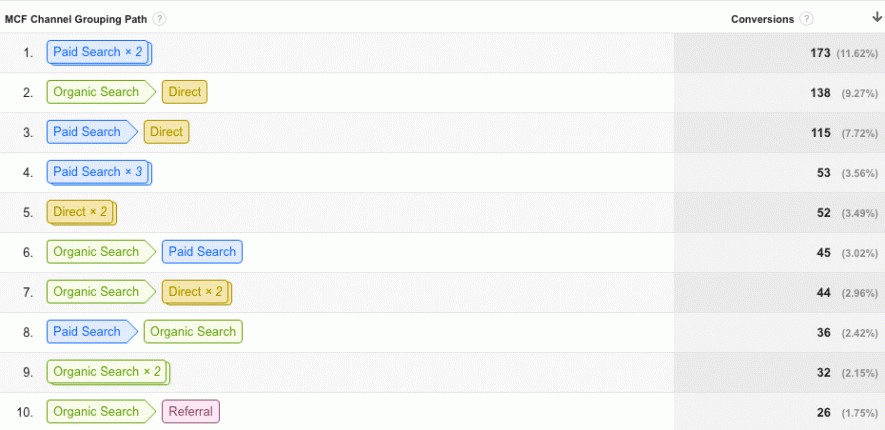Patrick Hoffmann Marketing Attribution in Five Steps Patrick Hoffmann 92 66 5 14 92 66 5 14
I’ll start by quoting one of my coworkers, not because we work together, but because of the fact that he’s right:
Being able to evaluate how each marketing channel is contributing to growth is the key to success.”
To do this, you have to fully understand the purpose of marketing attribution. I’m going to explain it in just a second! (I promise.)
Like many of you, I’ve put countless of hours into understanding every aspect of online marketing and still felt like I was missing something. Around six months ago, I realized how I had just groped blindly for the last two years with my marketing efforts. I had stumbled over this one phrase – marketing attribution – and it just clicked!
Marketing attribution is about allocating which marketing channels are contributing to growth.
And you'll say, “I use Google Analytics all day. I got the data I need."
Sure, you have all the data you need. However, you have to consider every aspect regarding tracking ad and marketing performances directly from Google Analytics.

The infographic from this coverage of marketing attribution is of course a short introduction to an area which is gigantic. However, we have never had as much data as we have today to do a proper analysis.
Unfortunately, this is a marketing discipline that is extremely difficult to master even for us who have been in the game for many years.
Let's look at the five steps to marketing attribution!
1. Which channels are the most important
This is actually very important. Maybe you are spending a lot of efforts on optimizing your website for SEO rankings or a lot of money on Google AdWords. You have to find the top 3 to 5 channels and put them in a prioritized list.
You can look at your data in Google Analytics under the Acquisitions menu in the left sidebar. If you've checked the 'All traffic' tab it could look something like this:
- Google / Organic
- Direct / (none)
- Google / cpc
- Facebook / referral
- E-mail / newsletter
It's important to note which period you are dealing with when you put this data into a spreadsheet.
2. Make sure to have the correct cost data
You need to know the exact cost data for each attribute if you wish to know which channel is the most profitable. That’s also why you need to choose 3 to 5 channels so that you can compare them to each other. Otherwise, the attribution modeling won’t give you any useful data.
You also have to consider the relative cost associated with the channels like newsletter and organic traffic. Maybe you have hired an agency to build your sites link profile that have an effect on rankings and you may also pay a newsletter tool like Mailchimp to provide you with the newsletter software. The approximate cost for each month should be added to your channel.
3. Choose a model

You can make a model comparison in Google Analytics: Google Analytics → Conversion → Attribution → Model Comparison Tool.
Note: There's no right or wrong in attribution modeling. It's all about getting closer to how you should attribute credit to the channels that drive traffic to your site.
4. Create an overview
Get your channels listed, your cost next to them and revenue, conversions or goals on the right side. Don’t be shocked if you see channels without revenue, conversions, etc. and don’t spend time on them right now. Just go to your Google Analytics interface and start working with the actual interface.
On the far right side you’ll see a percentage decrease or increase. Take that number and add it to your sheet. When you multiply this number with the number of revenue, conversions or goals you’ll get a new factor. This is where the fun begins. Take the new value factor and calculate your ROI or CPA. Compare the new ROI or CPA with the old ones, and you’ll discover that some channels are not performing as good or bad as they did when you used your previous reporting tools.
5. Go change the world
Now – put your new data to use. You could change your marketing budget allocation or how you and your colleague spend time working with marketing channels. Simon Paag, former Google-man and now Partner at Spinnaker Nordic told me that in his experience companies comes to a number of conclusions when working with marketing attribution:
- They spend way too much money on affiliate marketing.
- They spend way too little effort on e-mail marketing.
- They need to spend more efforts on optimizing AdWords.
- They need an audit of their entire online marketing setup.
- They need a new way of reporting on a weekly basis.
It all comes down to touch points during the conversion path
During the conversion path the customer interacts several times with your site before purchasing. Every interaction is defined as a touch point. If we dig deeper into how each channel is attribution to the conversion, you see something like this:
 (Google Analytics → Conversions → Multi-Channel Funnels → Top Conversion Paths).
(Google Analytics → Conversions → Multi-Channel Funnels → Top Conversion Paths).
Paid Search is the top performer by far but number two, three and five has Direct as the last touch point before the conversion. And now I’m going to ask you a question:
“Did you know any of any brands when you were born?”
Probably not. That’s why this data is so freaking awesome! If you combine the numbers of conversions with Direct as the last touch point you’ll get 349!
As you can see there were touch points before the direct touch point – so if you ever think that you should give word-of-mouth and offline marketing all the credit for a sale, you must be sure that there haven’t been any interactions before the last click.
Sadly, this data only contains 90 days of data – so the top performer, Paid Search, could have one, two, three or more touch points before the 2x Paid Search in the end. So could the rest of the bundles.
To wrap it up, I just want to say that your marketing budget could be completely wrong if you haven’t allocated all of the touch points though the customer's conversion path.
Conclusion
The conclusion is that effective tracking and analyzing of all marketing channels is crucial for companies who want to know how much each channel should be present in the future marketing budget.
Hopefully, this article helped clarify the aspects of just how important it is to correctly allocate which channels are contributing to your conversions.
If you have any questions, please feel free to reach out to me in the comments below or check out my personal blog patrickhoffmann.dk.



